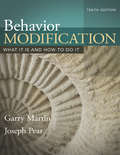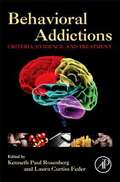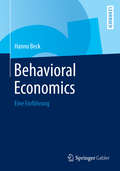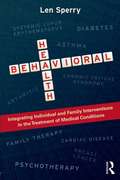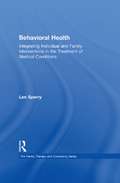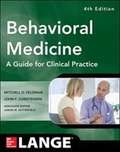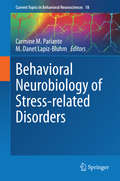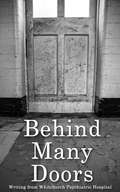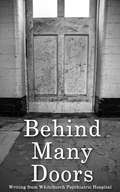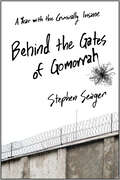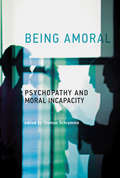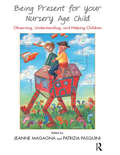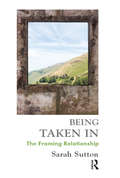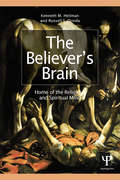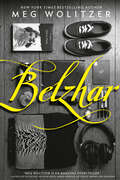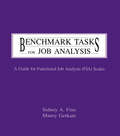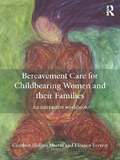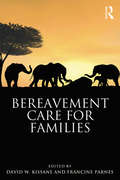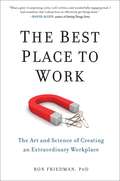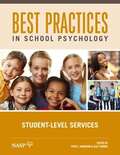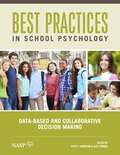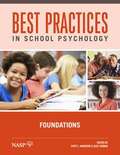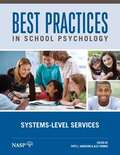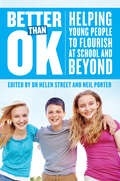- Table View
- List View
Behavior Modification: What It Is and How To Do It
by Garry Martin Joseph J. PearBehavior Modification,10/e assumes no specific prior knowledge about psychology or behavior modification on the part of the reader. The authors begin with basic principles and procedures of behavior modification and then provide readers with how-to-skills such as observing and recording. Next, the authors provide advanced discussion and references to acquaint readers with some of the empirical and theoretical underpinnings of the field. Readers will emerge with a thorough understanding of behavior modification in a wide variety of populations and settings.
Behavioral Addictions: Criteria, Evidence, and Treatment
by Kenneth Paul Rosenberg Laura Curtiss Feder<p>DSM-V broke new ground in May of 2013, designating a new disorder called "behavioral addiction." Clinicians immediately wanted to know: how is a behavioral addiction different from an impulse control disorder? What are the criteria for determining that some behaviors are addictions rather than impulses? What, if anything, does this mean in terms of effective treatment? <p>Behavioral Addictions is the first and most authoritative text ever written on the subject of behavioral addictions. This comprehensive work explains the criteria used to determine addiction, the evidence for identifying assorted behaviors as addictions, and the evidence-based treatment for each. <p>With contributions from preeminent experts covering an exhaustive list of behavioral addictions, this book is unique in its coverage of behavioral addictions, their criteria, and treatment. It is a valuable and timely resource for any clinician treating addictions.</p>
Behavioral Economics: Eine Einführung
by Hanno BeckSeit den siebziger Jahren haben die Erkenntnisse und Forschungen der Psychologie auch Einzug in die Wirtschaftswissenschaften gehalten – sie sollen das Menschenbild der Ökonomen und ihre Modelle realistischer machen. Dieses Buch beschreibt die wichtigsten Methoden, Konzepte und Erkenntnisse der verhaltenswissenschaftlichen Ökonomik (Behavioral Economics) und weitere dazugehörige Forschungsgebiete wie Glücksforschung, Fairness und Neuroökonomie. Das Lehrbuch stellt die wichtigsten theoretischen und empirischen Befunde und Ideen vor, um sie anschließend einer kritischen Würdigung zu unterziehen. Es ist sowohl für Studierende geeignet als auch für Dozenten und Wissenschaftler, die sich über den aktuellen Forschungsstand der Disziplin informieren wollen.
Behavioral Health: Integrating Individual And Family Interventions In The Treatment Of Medical Conditions
by Len SperryThe emergence of behavioral health, how it is practiced, and how it will be practiced is at the heart of this book. Len Sperry, a prominent author and educator, is one of the first to describe and advocate for an approach to health care that can significantly increase the efficacy and efficiency of health care and reduce costs for patients with chronic medical conditions. He does so by addressing both core theoretical constructs and core practice competencies to help readers comfortably provide effective integrated psychosocial treatment to individuals and families. <p><p> His book is split into three parts. The first provides an overview of the key family and personality dynamics and how medical conditions impact individual and family members throughout the family life cycle. Important considerations in this part include ethical and clinical issues, spiritual considerations, treatment non-compliance, motivational interviewing, and case conceptualization. Of particular importance is Dr. Sperry’s description of four illness stages, which reflect patients’ psychosocial adjustment to their chronic illnesses. The second part consists of seven chapters dedicated to common medical conditions, followed by the last part that addresses integrated behavioral health competency and competency-based training. <p> Behavioral health clinicians and trainees in various behavioral health specialties, including individual psychotherapists and family therapists, will find this practical book of interest and value to their work. No matter their experience, all readers will walk away from this book with the knowledge necessary to increase motivation, deal with non-compliance issues, and tailor therapeutic change, while increasing treatment efficacy and efficiency with their patients.
Behavioral Health: Integrating Individual and Family Interventions in the Treatment of Medical Conditions (Routledge Series on Family Therapy and Counseling)
by Len SperryIn this age of accountability, and irrespective of whether they work in health-care settings or conventional mental health settings, all therapists will be increasingly expected to provide effective psychosocial treatment to individuals and families who face co-morbid medical conditions. Statistics these conditions are daunting: 75 percent of adults over age 65 and 50 percent of Americans constantly experience chronic medical symptoms, and prevalence rates of chronic medical conditions that are more than three times higher than mental illness. While it can be helpful to conceptualize treatment in terms of individual dynamics and utilize cognitive behavioral strategies, it can be much more effective to conceptualize family as well as individual dynamics and to utilize systemic interventions when indicated. Effective Treatment of Individuals and Families Facing Medical Conditions addresses the need for these types of interventions. It provides background information on 12 common medical conditions, and includes discussions of family dynamics as well as medical and psychosocial treatments. While recognizing the role of personality, culture, and illness dynamics, it emphasizes the centrality of family dynamics in conceptualizing and implementing interventions.
Behavioral Medicine A Guide For Clinical Practice 4/e
by Mitchell D. Feldman John F. ChristensenThe goal of Behavioral Medicine is to help practitioners and students understand the interplay between psychological, physical, social and cultural issues of patients. Within its pages you will find real-world coverage of behavioral and interactional issues that occur between provider and patient in everyday clinical practice. You will learn how to deliver bad news, how to conduct an effective patient interview, how to care for patients at the end of life, how to clinically manage common mental and behavioral issues in medical patients, the principles of medical professionalism, motivating behavior change, and much more. As the leading text on the subject, this trusted classic delivers the most definitive, practical overview of the behavioral, clinical, and social contexts of the physician-patient relationship. The book is case based to reinforce learning through real-world examples, focusing on issues that commonly arise in everyday medical practice and training. One of the significant elements of Behavioral Medicine is the recognition that the wellbeing of physicians and other health professionals is critically important to caring for patients. Enhanced by new and updated content throughout, Behavioral Medicine provides insight and information not available anywhere else for those who seek to provide comprehensive high-quality care for patients. And it does so in a way that acknowledges patients as people who have problems that often go far beyond the reach of traditional medical care.
Behavioral Neurobiology of Stress-related Disorders (Current Topics in Behavioral Neurosciences #18)
by Carmine M. Pariante M. Danet Lapiz-BluhmStress is such an over-used word that it is at time difficult to define its core features. When is an environment stressful? What does a stressful environment do to the brain and to the body? What are the biological mechanisms by which a stressor affects us? How does stress contributes to the onset and the progression of mental disorders? How do the effects of stress change over the life-time of an individual? These are just some of the overarching questions addressed by this book, thanks to the contribution of some of the world leading experts on the neurobiology of stress at the pre-clinical and clinical levels. Topics include current advances on the neurobiology of stress on various neurobiological systems such as immune, hypothalamic-pituitary-adrenal (HPA) axis, neurogenesis and neuroplasticity, neurotransmitter (glutamate, noradrenaline, dopamine, serotonin and endocannabinoid), neuropeptides, cognition and emotional processing as well as in utero and early postnatal effects. The clinical chapters deal with the relationship of stress and mental disorders such as depression, posttraumatic stress disorder (PTSD), anxiety disorders, schizophrenia, bipolar disorder, substance abuse and addiction, dementia and age-related cognitive decline as well as resilience to stress. Thus, this book brings together some of the most updated and authoritative views on the effects of stress of brain and behavior.
Behind Many Doors
by Phil CarradiceBehind Many Doors is a vivid and revealing portrait of an Edwardian psychiatric hospital in Cardiff, created by those who know it most intimately. Whitchurch Hospital, formerly Cardiff Asylum, will cease to admit in-patients from 2016, marking the beginning of its gradual closure over the following years. This unique anthology seeks to capture, preserve and shine a light on what Whitchurch Hospital has meant and still means to service users, staff, visitors and members of the local community across its long and complex history. Readers are invited to experience the hospital from every angle, from the water tower's outline spied from the top deck of a Cardiff bus, right down to the cigarette burns on the ward carpet. Sometimes shocking, often moving, always illuminating, this collection of writing will compel all those who turn its pages to think anew about the mental healthcare of the past and the future and to look again at a building that has impacted upon the lives of so many.
Behind Many Doors
by Phil CarradiceBehind Many Doors is a vivid and revealing portrait of an Edwardian psychiatric hospital in Cardiff, created by those who know it most intimately. Whitchurch Hospital, formerly Cardiff Asylum, will cease to admit in-patients from 2016, marking the beginning of its gradual closure over the following years. This unique anthology seeks to capture, preserve and shine a light on what Whitchurch Hospital has meant and still means to service users, staff, visitors and members of the local community across its long and complex history. Readers are invited to experience the hospital from every angle, from the water tower’s outline spied from the top deck of a Cardiff bus, right down to the cigarette burns on the ward carpet. Sometimes shocking, often moving, always illuminating, this collection of writing will compel all those who turn its pages to think anew about the mental healthcare of the past and the future and to look again at a building that has impacted upon the lives of so many.
Behind Many Doors
by Phil CarradiceBehind Many Doors is a vivid and revealing portrait of an Edwardian psychiatric hospital in Cardiff, created by those who know it most intimately. Whitchurch Hospital, formerly Cardiff Asylum, will cease to admit in-patients from 2016, marking the beginning of its gradual closure over the following years. This unique anthology seeks to capture, preserve and shine a light on what Whitchurch Hospital has meant and still means to service users, staff, visitors and members of the local community across its long and complex history. Readers are invited to experience the hospital from every angle, from the water tower’s outline spied from the top deck of a Cardiff bus, right down to the cigarette burns on the ward carpet. Sometimes shocking, often moving, always illuminating, this collection of writing will compel all those who turn its pages to think anew about the mental healthcare of the past and the future and to look again at a building that has impacted upon the lives of so many.
Behind the Gates of Gomorrah: A Year with the Criminally Insane
by Stephen SeagerA darker twist on Orange is the New Black, this true insider's account delivers an eye-opening look into the nation’s largest state-run forensic hospital, a facility that houses the real-life Hannibal Lecters of the world.Psychiatrist Stephen Seager was no stranger to locked psych wards when he accepted a job at California’s Gorman State hospital, known locally as “Gomorrah,” but nothing could have prepared him for what he encountered when he stepped through its gates, a triple sally port behind the twenty-foot walls topped with shining coils of razor wire. Gorman State is one of the nation’s largest forensic mental hospitals, dedicated to treating the criminally insane. Unit C, where Seager was assigned, was reserved for the “bad actors,” the mass murderers, serial killers, and the real-life Hannibal Lecters of the world.Against a backdrop of surreal beauty—a verdant campus-like setting where peacocks strolled the grounds—is a place of remarkable violence, a place where a small staff of clinicians are expected to manage a volatile population of prison-hardened ex-cons, where lone therapists lead sharing circles with sociopaths, where an illicit underground economy flourishes, and where patients and physicians often measure their lives according to how fast they can run. To cross through the gates of Gomorrah is to enter a looking-glass world, where the trappings of the normal calendar year exist—Halloween dances and Christmas parties (complete with visits from Santa), springtime softball teams and basketball leagues, but marked with paroxysms of brutality (Santa goes berserk), and peopled by figures from our nightmares.Behind the Gates of Gomorrah affords an eye-opening look inside a facility to which few people have ever had access. Honest, rueful, and at times darkly funny, Seager’s gripping account of his rookie year blends memoir with a narrative science, explaining both the aberrant mind and his own, at times incomprehensible, determination to remain in a job with a perilously steep learning curve.
Being Amoral: Psychopathy and Moral Incapacity (Philosophical Psychopathology)
by Thomas SchrammeInvestigations of specific moral dysfunctions or deficits that shed light on the capacities required for moral agency. Psychopathy has been the subject of investigations in both philosophy and psychiatry and yet the conceptual issues remain largely unresolved. This volume approaches psychopathy by considering the question of what psychopaths lack. The contributors investigate specific moral dysfunctions or deficits, shedding light on the capacities people need to be moral by examining cases of real people who seem to lack those capacities. The volume proceeds from the basic assumption that psychopathy is not characterized by a single deficit—for example, the lack of empathy, as some philosophers have proposed—but by a range of them. Thus contributors address specific deficits that include impairments in rationality, language, fellow-feeling, volition, evaluation, and sympathy. They also consider such issues in moral psychology as moral motivation, moral emotions, and moral character; and they examine social aspects of psychopathic behavior, including ascriptions of moral responsibility, justification of moral blame, and social and legal responses to people perceived to be dangerous. As this volume demonstrates, philosophers will be better equipped to determine what they mean by “the moral point of view” when they connect debates in moral philosophy to the psychiatric notion of psychopathy, which provides some guidance on what humans need in order be able to feel the normative pull of morality. And the empirical work done by psychiatrists and researchers in psychopathy can benefit from the conceptual clarifications offered by philosophy.ContributorsGwen Adshead, Piers Benn, John Deigh, Alan Felthous, Kerrin Jacobs, Heidi Maibom, Eric Matthews, Henning Sass, Thomas Schramme, Susie Scott, David Shoemaker, Walter Sinnott-Armstrong, Matthew Talbert
Being Present for Your Nursery Age Child: Observing, Understanding, and Helping Children
by Jeanne Magagna Patrizia PasquiniThis book represents an innovative project in which parents, teachers and other professionals work collaboratively to observe children, understand them at a deep emotional level through their play and interaction with others, and facilitate their relationships with themselves as individuals and with others. The work described has been particularly important in nurturing children's creativity and fostering effective relationships between teachers, parents and children. The innovative nursery described has been an important preventative facility in promoting the wellbeing of young children. The Italian government has supported this highly esteemed project.
Being Taken In: The Framing Relationship
by Sarah SuttonWhy is love not enough for children whose early lives have been disturbing? What makes it so hard for such children to make the most of new relationships? How can we help children whose minds are adapted to adversity take in new experience? In the new era of brain research, neuroscience shows the way ahead. Being Taken In looks at the neuroscience showing how the mother/infant framing relationship wires in our way of understanding the world, and sets a navigation system, complete with built-in danger alerts. For disturbed children, these danger alerts are everywhere, and can even be triggered by the caregiver themselves. This makes the world a disturbing place, not just in the past, but right now. This book applies neuroscience and child development research to clinical practice, and points to emotional regulation through attunement and reflexivity as key factors in effecting change.
The Believer's Brain: Home of the Religious and Spiritual Mind
by Kenneth M. Heilman Russell S. DondaAbout 90% of people have faith in a supreme being, but our yearning for the divine, and whatever it promises, involves a large divergence in mental states and behaviors. Some adhere to doctrine, supplication, and fastidious religious practices; others have a strong sense they are part of something greater and more universal. However, all religious and spiritual paths are mediated by complex brain networks. When different areas of the brain are stimulated, a person can have a variety of experiences, but there is no specific ‘God spot’ where stimulation enhances religiosity or spirituality. Functional brain imaging shows that there are specific areas of the brain that ‘light up’ when subjects perform certain religious activities, but imaging only provides anatomic correlations, not functional explanations. The Believer's Brain takes a step beyond these singular methodologies, providing converging evidence from a variety study methods of how humans’ brain networks mediate different aspects of religious and spiritual beliefs, feelings, actions, and experiences. Although the book reveals how our brain is the home to the religious and spiritual mind, understanding this gift will not diminish our spirituality or our love or our belief in a supreme being, but will increase appreciation of the apparatus that mediates these mental states.
Belzhar
by Meg Wolitzer"Expect depth and razor sharp wit in this YA novel from the author of The Interestings." - Entertainment Weekly"A prep school tale with a supernatural-romance touch, from genius adult novelist Meg Wolitzer." --Glamour "Basically everything Meg Wolitzer writes is worth reading, usually over and over again, and her YA debut . . . is no exception." --TeenVogue.comIf life were fair, Jam Gallahue would still be at home in New Jersey with her sweet British boyfriend, Reeve Maxfield. She'd be watching old comedy sketches with him. She'd be kissing him in the library stacks. She certainly wouldn't be at The Wooden Barn, a therapeutic boarding school in rural Vermont, living with a weird roommate, and signed up for an exclusive, mysterious class called Special Topics in English.But life isn't fair, and Reeve Maxfield is dead. Until a journal-writing assignment leads Jam to Belzhar, where the untainted past is restored, and Jam can feel Reeve's arms around her once again. But there are hidden truths on Jam's path to reclaim her loss.
Benchmark Tasks for Job Analysis: A Guide for Functional Job Analysis (fja) Scales (Applied Psychology Series)
by Sidney A. Fine Maury GetkateHuman resource practitioners are repeatedly faced with the challenge of effectively using language to clearly describe the work performed on a job. Functional Job Analysis--an internationally recognized and respected job analysis method --has been meeting this challenge for more than forty years. In this book, the authors show how human resource practitioners can use structured task statements and comprehensive rating scales to gain the perspective needed to map the domain of any job. In response to the demands of human resource practitioners, the book focuses on the seven scales used in Functional Job Analysis. More than 450 structured tasks were used to illustrate the breadth and scope of all the levels of these scales. These tasks can be used effectively as benchmarks to chart the work requirements of virtually any job. Personnel practitioners will find insights into the challenges of job analysis, as well as the tools needed to make job analysis more comprehensive, useful, and effective for human resources. Representing the most comprehensive information to date on the use of Functional Job Analysis scales for rating job tasks, this book: *addresses the problems of using language to clearly describe how work is performed on the job; *describes the relation between the need to carefully control the language of job analysis and the structure inherent in the Functional Job Analysis Worker Function scales--a conceptual link showing the reader that the key to understanding work is in the vocabulary used to describe work; *contains the most comprehensive treatment of the way to write clear and comprehensive task statements available in the job analysis literature; and *contains a sample task bank for the job of Functional Job Analysts--aiding the reader in understanding how a complete Functional Job Analysis should look.
Bereavement Care for Childbearing Women and their Families: An Interactive Workbook
by Caroline Hollins Martin Eleanor ForrestFor many bereaved parents, the care provided by health professionals at birth – from midwives to antenatal teachers – has a crucial effect on their response to a loss or death. This interactive workbook is clearly applied to practice and has been designed to help practitioners deliver effective bereavement care. Providing care to grieving parents can be demanding, difficult and stressful, with many feeling ill equipped to provide appropriate help. Equipping the reader with fundamental skills to support childbearing women, partners and families who have experienced childbirth-related bereavement, this book outlines: What bereavement is and the ways in which it can be experienced in relation to pregnancy and birth Sensitive and supportive ways of delivering bad news to childbearing women, partners and families Models of grieving How to identify when a bereaved parent may require additional support from mental health experts Ongoing support available for bereaved women, their partners and families The impact on practitioners and the support they may require How to assess and tailor care to accommodate a range of spiritual and religious beliefs about death. Written by two highly educated, experienced midwifery lecturers, this practical and evidence-based workbook is a valuable resource for all midwives, neonatal nurses and support workers who work with women in the perinatal period. This book is suitable as a text for BSc and MSc courses in Midwifery; BScs courses in Paediatric Nursing; and for neonatal and bereavement counselling courses.
Bereavement Care for Families: Bereavement Care For Families (Series in Death, Dying, and Bereavement)
by David W. Kissane Francine ParnesGrief is a family affair. When a loved one dies, the distress reverberates throughout the immediate and extended family. Family therapy has long attended to issues of loss and grief, yet not as the dominant therapeutic paradigm. Bereavement Care for Families changes that: it is a practical resource for the clinician, one that draws upon the evidence supporting family approaches to bereavement care and also provides clinically oriented, strategic guidance on how to incorporate family approaches into other models. Subsequent chapters set forth a detailed, research-based therapeutic model that clinicians can use to facilitate therapy, engage the ambivalent, deal with uncertainty, manage family conflict, develop realistic goals, and more. Any clinician sensitive to the roles family members play in bereavement care need look no further than this groundbreaking text.
The Best Place to Work: The Art and Science of Creating an Extraordinary Workplace
by Ron FriedmanFor readers of Malcolm Gladwell, Daniel Pink, and Freakonomics, comes a captivating and surprising journey through the science of workplace excellence. Why do successful companies reward failure? What can casinos teach us about building a happy workplace? How do you design an office that enhances both attention to detail and creativity? In The Best Place to Work, award-winning psychologist Ron Friedman, Ph.D. uses the latest research from the fields of motivation, creativity, behavioral economics, neuroscience, and management to reveal what really makes us successful at work. Combining powerful stories with cutting edge findings, Friedman shows leaders at every level how they can use scientifically-proven techniques to promote smarter thinking, greater innovation, and stronger performance. Among the many surprising insights, Friedman explains how learning to think like a hostage negotiator can help you diffuse a workplace argument, why placing a fish bowl near your desk can elevate your thinking, and how incorporating strategic distractions into your schedule can help you reach smarter decisions. Along the way, the book introduces the inventor who created the cubicle, the president who brought down the world's most dangerous criminal, and the teenager who single-handedly transformed professional tennis--vivid stories that offer unexpected revelations on achieving workplace excellence. Brimming with counterintuitive insights and actionable recommendations, The Best Place to Work offers employees and executives alike game-changing advice for working smarter and turning any organization--regardless of its size, budgets, or ambitions--into an extraordinary workplace.
Best Practices in School Psychology: Student-Level Services
by Patti L Harrison Alex Thomas National Association of School PsychologistsThe content in this edition of Best Practices in School Psychology is expanded from earlier editions to include a broader range of topics, with considerable attention to multitiered, problem-solving, and evidence-based approaches for the delivery of effective school psychology services. The school psychology services outlined in this edition focus on improving student outcomes through data-based and collaborative activities in schools. Chapters emphasize prevention and intervention efforts for both student-level and systems-level services that recognize the importance of culture and individual differences across students, families, schools, and communities.
Best Practices in School Psychology: Data-Based and Collaborative Decision Making
by Patti L Harrison Alex ThomasThe latest edition of this professional staple outlines the most current, relevant, and valued information necessary for competent delivery of school psychological services.
Best Practices in School Psychology: Foundations
by National Association of School PsychologistsAn in-depth look at crisis, individual and school-wide interventions, and long-term student support. Before it's too late, learn how to best support your school. The completely revised second edition of Best Practices in School Crisis Prevention and Intervention contains all the information necessary for analyzing all aspects of school crisis. Explore the 37 chapters for an in-depth look at specific types of crisis, individual and school-wide interventions, and long-term supports to help students and the community heal. Be familiar with the tools to handle crisis prevention and intervention.
Best Practices in School Psychology: Systems-Level Services
by National Association of School PsychologistsThe latest edition of this professional staple outlines the most current, relevant, and valued information necessary for competent delivery of school psychological services.
Better Than Ok: Helping Young People to Flourish at School and Beyond
by Dr Helen Street Neil PorterThis is a book of up-to-date strategies for helping children—from their earliest years into adulthood—and is all about helping kids do more than just survive; these are strategies to help kids flourish. These solution-focused and easy-to-read essays are by 27 of the world's top experts in positive education. Learn to help children develop a lifelong love of learning with this practical and positive guide. Contributors include Michael Carr-Gregg, Maggie Dent, Andrew Fuller, and Tim Sharp.
